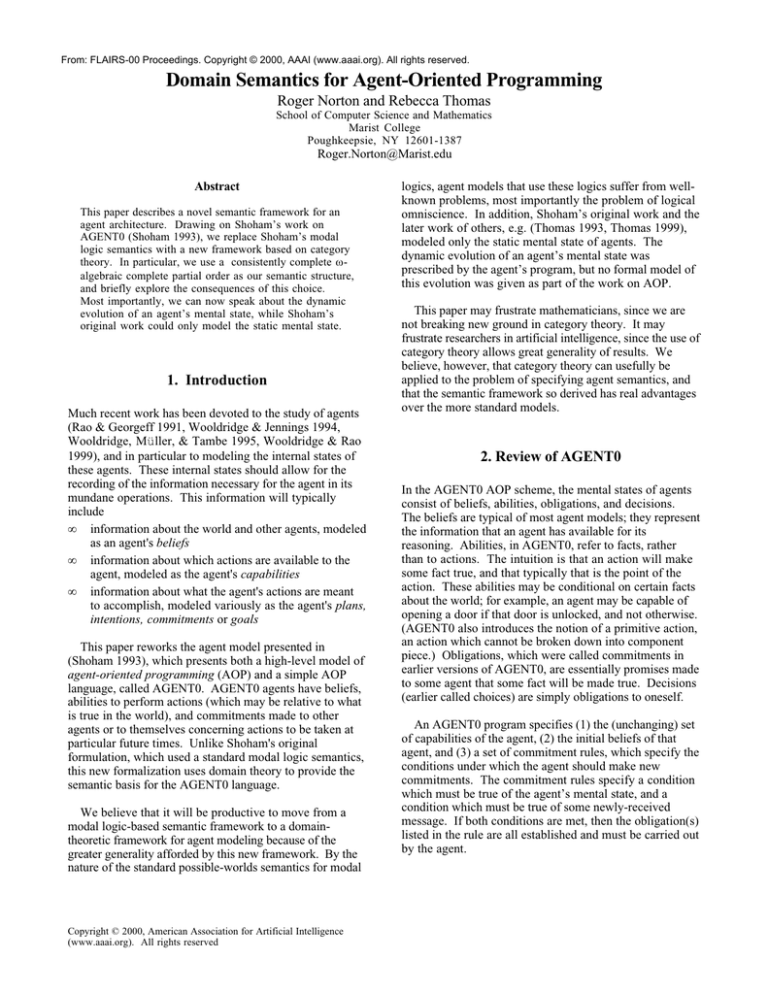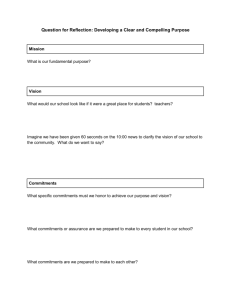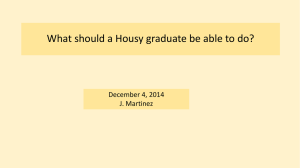
From: FLAIRS-00 Proceedings. Copyright © 2000, AAAI (www.aaai.org). All rights reserved.
Domain Semantics for Agent-Oriented Programming
Roger Norton and Rebecca Thomas
School of Computer Science and Mathematics
Marist College
Poughkeepsie, NY 12601-1387
Roger.Norton@Marist.edu
Abstract
This paper describes a novel semantic framework for an
agent architecture. Drawing on Shoham’s work on
AGENT0 (Shoham 1993), we replace Shoham’s modal
logic semantics with a new framework based on category
theory. In particular, we use a consistently complete ωalgebraic complete partial order as our semantic structure,
and briefly explore the consequences of this choice.
Most importantly, we can now speak about the dynamic
evolution of an agent’s mental state, while Shoham’s
original work could only model the static mental state.
1. Introduction
Much recent work has been devoted to the study of agents
(Rao & Georgeff 1991, Wooldridge & Jennings 1994,
Wooldridge, MŸller, & Tambe 1995, Wooldridge & Rao
1999), and in particular to modeling the internal states of
these agents. These internal states should allow for the
recording of the information necessary for the agent in its
mundane operations. This information will typically
include
• information about the world and other agents, modeled
as an agent's beliefs
• information about which actions are available to the
agent, modeled as the agent's capabilities
• information about what the agent's actions are meant
to accomplish, modeled variously as the agent's plans,
intentions, commitments or goals
This paper reworks the agent model presented in
(Shoham 1993), which presents both a high-level model of
agent-oriented programming (AOP) and a simple AOP
language, called AGENT0. AGENT0 agents have beliefs,
abilities to perform actions (which may be relative to what
is true in the world), and commitments made to other
agents or to themselves concerning actions to be taken at
particular future times. Unlike Shoham's original
formulation, which used a standard modal logic semantics,
this new formalization uses domain theory to provide the
semantic basis for the AGENT0 language.
We believe that it will be productive to move from a
modal logic-based semantic framework to a domaintheoretic framework for agent modeling because of the
greater generality afforded by this new framework. By the
nature of the standard possible-worlds semantics for modal
Copyright © 2000, American Association for Artificial Intelligence
(www.aaai.org). All rights reserved
logics, agent models that use these logics suffer from wellknown problems, most importantly the problem of logical
omniscience. In addition, Shoham’s original work and the
later work of others, e.g. (Thomas 1993, Thomas 1999),
modeled only the static mental state of agents. The
dynamic evolution of an agent’s mental state was
prescribed by the agent’s program, but no formal model of
this evolution was given as part of the work on AOP.
This paper may frustrate mathematicians, since we are
not breaking new ground in category theory. It may
frustrate researchers in artificial intelligence, since the use of
category theory allows great generality of results. We
believe, however, that category theory can usefully be
applied to the problem of specifying agent semantics, and
that the semantic framework so derived has real advantages
over the more standard models.
2. Review of AGENT0
In the AGENT0 AOP scheme, the mental states of agents
consist of beliefs, abilities, obligations, and decisions.
The beliefs are typical of most agent models; they represent
the information that an agent has available for its
reasoning. Abilities, in AGENT0, refer to facts, rather
than to actions. The intuition is that an action will make
some fact true, and that typically that is the point of the
action. These abilities may be conditional on certain facts
about the world; for example, an agent may be capable of
opening a door if that door is unlocked, and not otherwise.
(AGENT0 also introduces the notion of a primitive action,
an action which cannot be broken down into component
piece.) Obligations, which were called commitments in
earlier versions of AGENT0, are essentially promises made
to some agent that some fact will be made true. Decisions
(earlier called choices) are simply obligations to oneself.
An AGENT0 program specifies (1) the (unchanging) set
of capabilities of the agent, (2) the initial beliefs of that
agent, and (3) a set of commitment rules, which specify the
conditions under which the agent should make new
commitments. The commitment rules specify a condition
which must be true of the agent’s mental state, and a
condition which must be true of some newly-received
message. If both conditions are met, then the obligation(s)
listed in the rule are all established and must be carried out
by the agent.
In our model, we have made some minor changes. We
have replaced the idea of obligations with non-social
commitments, that is, with commitments that are not
made to any particular agent. (While it is useful to have
social commitments, we are confident that only a small
change will be required to our model to incorporate this
notion.) We divide commitments into two types, simple
commitments, in which an agent agrees to establish some
fact at a given time, and conditional commitments, in
which the agent agrees that it will establish the given fact
at the given time if some condition is then true. For
example, our agent may promise to open the door to the
seminar room at 3:00pm, if the door is then unlocked.
3. Intuitive example
While the mathematics underlying our model will be
presented in detail below, it seems appropriate to give
some intuitive description in order to illustrate our
approach.
We model our agent’s mental state with a collection of
elements, which are arranged to form a complete partial
order (see Figure 1). Each element is a potential belief
state of the agent; that is, it can be seen as a collection of
facts. Some elements of the partial order correspond to
messages received by the agent; the contents of a message
can be seen as a collection of facts. One element is singled
out as the initial belief state of the agent. Whenever the
agent receives a message, it moves to a new belief state.
This new belief state is found by taking the least upper
bound of the current belief state and the just-received
message, subject to consistency constraints.
S
X.
Y
X.¬
Y
¬X.
Y
X
Y
¬X
¬X.¬
Y
¬Y
z
Figurebelief
1 state be [X]. If the
In Figure 1, let the initial
agent receives a message with content [Y], its new belief
state will be the least upper bound of [X] and [Y], which is
in this case [X.Y]. Should the agent next receive the
message [X], its new belief state will remain [X.Y].
Thus this diagram captures the evolution of the agent’s
beliefs in response to messages it might receive.
.
S
X.
X.¬
¬X.
¬X.¬
Y
Y
Y
X
Y
¬X Y
¬Y
z
Figure 2
Let us examine another possible set of elements, which
will give us different results. Figure 2 shows the mental
state of a nonlearning agent. Starting from belief state "⊥"
this agent can learn one thing. Any further learning will
put it into an inconsistent state.
Obviously, both Figure 1 and Figure 2 describe very
simple agents. This same framework is very general and
can capture many different styles of agent reasoning.
4. A Mathematical Structure for Defining the
Semantics of Agents
When investigating what mathematical structure would be
appropriate to model both the static and dynamic nature of
an agent we initially tried utilizing Kripke diagrams.
These proved to be adequate for modeling the static nature
of an agent but we had difficulty in dealing with the
agent’s dynamic nature. We briefly investigated Montague
semantics, which avoid some problems of Kripke models
by weakening the assumed reasoning power of agents, but
found them equally problematic in terms of representing
the dynamic mental state. We next turned to category
theory, specifically to a fairly general category that is often
used in semantic models, namely a Cartesian closed
category (MacLane 1971). This proved to be adequate to
model both the static and dynamic nature but had the
disadvantage of being too general. There were aspects of a
Cartesian closed category that did not correspond to any
characteristic of an agent within our denotation. We next
honed in on what aspects of these categories were in fact
needed for our model to work. What we concluded was
that a form of a Scott Domain (Scott 1982), namely, a
consistently complete ω-algebraic complete partial order,
henceforth called simply a domain, was what was needed.
Before we proceed with the details of our model, let us
first enumerate a few of the properties of the category of
domains that will play a prominent role in our model:
1. this category is in fact Cartesian closed and so
terminal elements, products, and function types
are available.
2. the function U:DxD→D, which maps two elements
to their least upper bound, is continuous.
3.
4.
5.
6.
every domain D contains a set of elements fin(D),
called the finite elements, which satisfy the
property that if x∈fin(D), M⊆D is a directed set,
and x≤UM, then x≤y for some y∈M. (Winskel &
Larsen 1984)
for each element x∈D we define ↑x = {a∈fin(D) |
a≤x} and have that ↑x is directed and U(↑x) = x,
so in fact a domain is determined by its finite
elements.
Given a function f:fin(D)→D that is monotonic, it
can always be extended to a function f^:D→D that
is continuous. This tells us that continuous
functions are completely characterized by their
actions on the finite elements.
•
•
•
Each domain D has a bottom element ⊥ . We will
also require the existence of a top element S .
particular agent. All abilities in Aa are determined by
these primitives as discussed in (4) above.
Beliefs Ba :T→Aa, correspond to the beliefs of an
agent represented as a continuous function of time.
Since continuous functions are monotonic, Ba will be
monotonic with respect to the ordering on T and Aa.
This function captures a part of the dynamic nature of
an agent.
Simple Commitments Sa: T→Aa. These are the
commitments that an agent has made represented as a
continuous function of time.
Conditional Commitments Ca: T→( Pa →Aa).
These are the conditional commitments that an agent
has made represented as a continuous function of time.
The condition associated with a conditional
commitment must be a primitive.
4.1 The Semantic Domains of Agents
4.2 The Semantic Functions
In order to define our model we will need to introduce the
following domains:
• Time T = N∞ , which is the domain of natural numbers
with an element ∞ attached to the top of the order, or
T = n, which is the domain of natural numbers up to
and including n. On each of these domains is defined
a continuous function next: T→ T which maps each
element to the next element in the partial order.1
• Domain of Discourse D. This domain models the
world of all the agents and will usually be, but not
required to be, defined using a predicate logic over a
basis in which the ordering is based on implication.
Each element φ in this domain would probably be a
consistently complete set of predicates with φ≤ϕ iff all
models of φ are also models of ϕ.
• Negation. ¬: D→D, an idempotent operator
satisfying U(¬φ,φ) = S .
• Abilities Aa ⊆ D. These domains, one for each agent,
will be subdomains of the domain D and represent the
abilities of an individual agent. Since the abilities of
individual agents differ, we cannot utilize D to model
the abilities of all agents. (Note that we follow
Shoham in defining abilities to relate to facts rather
than actions.)
• Primitives Pa= fin(Aa). The primitives correspond
to the primitive actions (facts) associated with a
Initialization: When an agent is specified, an
initialization element φ ∈Aa is given. This element
specifies the initial beliefs of the agent and thus defines an
initial value for Ba given by the formula Ba (t) = φ for all
t∈T2. Also specified at this time are a finite number of
initial commitments, both simple and conditional. These
result in initial values for the functions Sa and Ca with the
restrictions Sa(t)=Sa(next(t)) for t≥t0 for some t0∈T and
Ca(t)=Ca(next(t)) for t≥t1 for some t1∈Ta. This condition
ensures that only a finite number of commitments were
made at initialization.
Effects of Commitments on Beliefs: As time passes, an
agent’s beliefs changes based upon information it receives
from other agents, and based upon commitments made by
the agent to itself and to other agents. These
commitments also cause actions to be performed by the
agent as a result of “side effects”.
The changes in the beliefs of an agent due to its simple
commitments at time next(t), where t∈T, is described by
the formula
Ba(next(t)) = Ba(t)USa(t).
This formula correspond to the following commutative
diagram:
T
next
T
B a xS a
Ba
1
. We have investigated models which included more
complex domains of time which would allow for each
agent to function on a different time scale Ta. This would
require the existence of a functor Fab:Ta àTb , for pairs of
agents a and b. We do not discuss this more elaborate
model of time in this paper.
.
A a x Aa
2
U
Aa
Since Ba is required to be continuous, and thus
monotonic, we cannot simply define Ba(0)=φ.
In the case where our domain corresponds to some
predicate logic, the above asserts that at time next(t), what
we believe is what we believed at time t anded with what
we were committed to believe at time t. These changes
also result in primitive actions being performed by the
agent. We specify these actions as side effects of the
primitive elements in our domains. Thus at time next(t)
an agent performs the actions:
{Do p ∈ P a |
p ≤ Sa(t) & p % Ba(t) }
Thus, if an agent commits to believing at time t that it has
just performed the open-door action, then at time t it will
add such a belief to its knowledge base and will perform
the open-door action, unless the door is open already.
Similarly, the changes in the beliefs of an agent due to
its conditional commitments at time next(t), where t∈T, is
described by the formula
Ba(next(t)) = Ba(t)UCa(t)( Ba(t)).
Note here that the commitments that are acted upon are the
ones determined by both the time t and the current beliefs
Ba(t ). This formula corresponds to the following
commutative diagram:
T
next
T
Ba x Ca x Ba
Aax(Aa→Aa)xAa
Ba
A a xA a
id x apply
Aa
U
These changes cause the following primitive actions to be
performed by the agent
{Do p ∈ P a |
p ≤ Ca(t)( Ba(t)) & p % Ba(t)} .
Incoming Messages: When a message is sent to an agent
it will be intercepted by the system interface and converted
to an appropriate form for processing by the agent. The
messages that are received are of two forms: Informational
and Requests.
Informational messages are simply informing agenta of
some fact φ. The agent will then, depending on the time
t0 when the message is received, adjust its beliefs
accordingly. This adjustment is represented by the
formula
Ba(t) = Ba(t)Uφ for t ≥ t0.
Requests are messages requesting agenta to commit to
some fact φ at a time t0. This request may be conditional
on some primitive fact p being true at the time. Again the
system interface intercepts these messages and converts
them to an appropriate form for processing by the agent. In
the case of a simple request (t0, φ) the adjustment is
represented by the formula
Sa(t) = Sa(t)Uφ for t ≥ t0,
.
and for a conditional request (t0, (p, φ)) the adjustment is
represented by the formula
Ca(t) = Ca(t)Uf^(p,φ) for t ≥ t0,
where we have f(p,φ): Pa→ Aa is defined by
φ
f(p,φ)(q) =
⊥
for q ≥ p.
otherwise.
The function f^(p,φ): Aa→ Aa is the continuous extension of
f(p,φ): Pa→ Aa that was discussed in (5) above.
Informational Relevancy: In the scenario described above
an agent did not examine the content of a fact φ to insure
that its content was relevant to the domain of the agent.
This scenario thus assumes that each agent knows the
abilities of the other agents, or at least the ones for which it
is interested in communicating with. If an agent does not
know about the abilities of another agent, it really has no
vocabulary for even representing any information about
these unknown abilities. In such cases, we can always
adjust any incoming messages to fit within the domain of
abilities of the particular agent. So for example, if agent a
receives a fact φ from agentb, the system can then pass on
to the agenta simply the fact φ’ = U{p ∈ Pa | p ∈ ↑φ},
which of course may simply be ⊥ .
Beliefs: In our world of agents we are interested in what
our agents “believe” at some time t. This of course is
determined by investigating Ba(t) . To determine whether
agenta believes fact φ at time t, we simply determine if
φ ≤ Ba(t). If it is, we say that agenta believes φ at time t
and write Ba(t)(φ). Since we require that U (¬φ, φ) = S, if
agenta believes both ¬φ and φ at time t, then agenta
believes S and thus believes all things. We will refer to
this as agenta being in a state of inconsistency. What
about the question of what agenta does not believe?
Definition: We define ¬Ba :T→PowerSet(Pa) where
¬Ba(t) = {p ∈ Pa | p ∉ Ba(t) }. We then say that agenta
does not believe fact φ at time t iff (↑φ ∩ ¬Ba(t)) ≠ ∅
and will write ¬Ba(t)(φ).
Lemma: If agenta is in a consistent state, then we have
that Ba(t)( ¬φ) implies that ¬Ba(t)(φ).
Consistency. We have not imposed any consistency
constraints on our agents’ beliefs. Thus it is possible for
an agent to believe both φ and ¬φ, and hence be in a state
of inconsistency. This may be an undesirable situation.
We can however, easily remedy this by imposing a few
consistency constraints. For instance we can impose
1. Any initialization element φ be consistent, so φ ≠ S.
2. For commitments we would have
Ba(t)USa(t)
if Ba(t)USa(t) ≠ S
Ba(next(t)) =
Ba(t)
otherwise
3. For conditional commitments we would have
Ba(t)UCa(t)(Ba(t)) if Ba(t)UCa(t)( Ba(t)) ≠ S
∀X,Y,Z,T Ba (T)(S(0,X,Y,Z,T)) ⇒ MR(T)
∀Y,Z,T Ba (T)(S(1,0,Y,Z,T)) ⇒ MF(T)
∀Z,T Ba (T)(S(1,1,0,Z,T)) ⇒ ML(T)
∀T Ba (T)(S(1,1,1,0,T)) ⇒ MB(T)
Ba(next(t)) =
Ba(t)
otherwise
We could similarly impose consistency constraints on the
incoming messages processed by our agent.
5. Example
Let us present an example in which an agent is to find its
way out of a maze. The agent will be programmed to use
the algorithm in which it figuratively places its right hand
on the wall and moves in such a way as to keep contact
with the wall at all times. That is, if the agent can turn
right, it will; if it cannot turn right but can go straight, it
will. If it cannot turn right or go straight but can turn left,
it will, and if it can do none of these things, it will turn
around and return to its previous position (but now facing
the other way).
We will model this example using a modus ponens
domain. In this structure, we have a set of predicates. We
will not need conjunction or disjunction for this example,
but we will need implication. An element of the domain
is just a set of well-formed formulas (wffs), where each wff
is either a predicate or an implication.
We’ll assume that our agent has sensors that allow it to
recognize whether there is a wall in front of it, on its left,
on its right, and behind it. We will encode this
information using a 5-ary state predicate S(R, F, L, B, T).
The first four terms of the predicate are Boolean; they are 1
if there is a wall respectively to the right of, in front of, to
the left of, or behind the agent. The final term, T, is a
time. So S(1,0,0,1,15) will be interpreted to mean that at
time 15, the agent had walls to its right and behind it, but
not to its left or in front of it. We will have four more
predicates: MR(T) means that the agent turns to its right
and moves one unit forward at time T. Similarly,
MF(T1), ML(T2), and MB(T3) mean that the agent moves
forward, left, and back at the given times. These predicates
have side effects; if the agent adopts a belief in, say, MR(T)
then it will execute the corresponding action at time T.
(Note that the agent can only adopt this belief if it is
consistent with the agent’s other beliefs.)
Given this language, we can write rules that will allow
the agent to execute the algorithm described above. Note
that although our language for this example does not allow
quantifiers, we will use them as an abbreviation. In fact,
each element in the domain will have an infinite number of
implication instances corresponding to each rule given
here.
.
Of course, our semantic framework is more general than
the maze example demonstrates. As a second example, we
present the standard nonmonotonic reasoning problem
concerning whether Tweety the bird can or cannot fly. We
can draw a simple domain for this reasoning problem; see
Figure 3.
The initialization element for this example is
{bird(Tweety)→flies(Tweety), dead(Tweety)→
¬flies(Tweety)}; these are the only things the agent
believes when it first begins operation. Note that the →
symbol now represents defeasible implication. Should it
now learn that Tweety is a bird, it will conclude that
Tweety can fly. If instead it learns that Tweety is dead, it
will conclude that Tweety cannot fly. Should it learn that
Tweety is both dead and a bird, it will still conclude that
Tweety cannot fly, regardless of the order in which it learns
these two facts.
S
bird(Tweety), dead(Tweety),
¬flies(Tweety)
bird(Tweety)→flies(Tweety)
de d(Tweety)→ flies(Tweety)
dead(Tweety), ¬ flies(Tweety)
bird(Tweety)→flies(Tweety)
dead(Tweety)→ ¬ flies(Tweety)
bird(Tweety), flies(Tweety)
bird(Tweety)→flies(Tweety)
dead(Tweety)→
¬flies(Tweety)
bird(Tweety) bird(Tweety)→flies(Tweety) dead(Tweety)
dead(Tweety)→
¬flies(Tweety)
z
Figure 3
6. Discussion
As a result of the semantic structure given above, an
agent’s beliefs can change through receiving messages and
through side effects of commitments and conditional
commitments. It may seem unintuitive that an agent
should be able to make a commitment to believe
something in the future. Often, however, the agent will
make a commitment to believe that it took some action at
a given time; as a side effect, then, the agent will take the
action. The agent may have information about the effects
of its actions, but it need not conclude that its actions are
always successful. For example, an agent program may
specify that an agent commit to believing at 4:00pm that at
3:59pm it performed an open-door action on the door of the
seminar room. Its program may further specify that it
should always believe that such an action entails the door
being open afterward, or its program may instead specify
that once the action is performed, the agent should adopt a
belief that the door is open only if its sensors confirm that
fact. Either approach is consistent with the AOP
paradigm, since Shoham purposely did not specify how
agents should reason about the results of their actions.
AOP was intended to be a very general approach to
programming agents. We believe that we have further
generalized the approach by replacing the Kripke-style
semantic structures used by Shoham (Shoham 1993) and
Thomas (Thomas 1993, Thomas 1999) with a Scott
Domain. Within this framework, the user is free to specify
that an agent should be a perfect reasoner, but the user is
equally free to specify that an agent is incapable of
reasoning at all, or can perform only certain kinds of
reasoning. Such reasoning abilities are encoded in the
structure of the domain, specifically in the elements and the
function U (which maps two elements to their least upper
bound).
7. Future Work
In this paper we have introduced two fairly conventional
forms of commitments, namely Sa: T→Aa and Ca: T→( Aa
→Aa). However, due to the fact that our category of
domains is Cartesian closed, we can easily introduce more
complex versions of commitments. For instance we could
define a recursive form of commitment that would allow us
to commit to at time t0 to commit to at time t1 to believe
in fact φ. This could be accomplished by defining a
domain of high level commitments Ha = Sa + Ca + Ha. In
our current investigations we are exploring these high level
commitments as well as investigating the use of a more
complex domain of time Ta.
One problem with our model as it stands is that we have
not discussed nested belief operators; that is, we have no
way of representing what an agent believes about its own
beliefs or the beliefs of other agents. Such nesting of belief
operators is crucial in many domains, and we are currently
investigating extensions to our work that will allow such
nesting.
References
(Apt 1981) Apt, K.R. “Ten Years of Hoare's Logic: A
Survey --Part I,” ACM Transactions on Programming
Languages and Systems, 3: 4, ACM, 1981.
.
(Attardi & Simi 1981) Attardi, A. and Simi, M.
“Semantics of Inheritance and Attributes in the Description
System Omega,” MIT A.I. Memo 642, 1981.
(Cardelli 1988) Cardelli, L. “A Semantics of Multiple
Inheritance,” Information and Computation, number 76,
pages 138-164. Academic Press, 1988.
(Goguen et al, 1973) Goguen, J. A., Thatcher, J. W.,
Wagner, E. G., and Wright, J. “A Junction Between
Computer Science and Category Theory, I: Basic Concepts
and Example(Part I).” IBM Research Report, 1973.
(Goguen et al, 1976) Goguen, J. A., Thatcher, J. W.,
Wagner, E. G., and Wright, J. “An Introduction to
Categories, Algebraic Theories, and Algebras.” IBM
Research Report, 1976.
(Goguen et al, 1977) Goguen, J. A., Thatcher, J. W.,
Wagner, E. G., and Wright, J. “A Junction Between
Computer Science and Category Theory, I: Basic Concepts
and Example(Part II).” IBM Research Report, 1977.
(Hoare 1969) Hoare, C. A. R. “An Axiomatic Basic for
Computer Programming,” Communications of the ACM,
12:10, 1969.
(Liskov & Guttag 1986) Liskov, B. H. and Guttag, J.
Abstraction and Specification in Program Development,
MIT Press, Cambridge, 1986.
(MacLane 1971) Mac Lane, S. Categories for the Working
Mathematician, Graduate Texts in Mathematics, SpringerVerlag, New York, 1971.
(Norton 1987) Norton, R. L. “Information Systems as
Implementations,” Proceedings of the 15th Annual
Computer Science Conference, St. Louis, Missouri, 1987.
(Norton 1989) Norton, R. L. “Predicate Transformers as
Homomorphisms on Scott's Information Systems,”
Proceedings of the 17th Annual Computer Science
Conference, Louisville, Kentucky, 1989.
(Norton 1991) Norton, R. L. “A Categorical Treatment of
Classes in an Object-Oriented Language,” Marist Working
Papers, V.7, 1991.
(Norton 1991) Norton, R. L. “A Categorical Treatment of
Classes and Multiple Inheritance in an Object-Oriented
Programming Language,” Dissertation, Syracuse
University, 1991.
(Rao & Georgeff 1991) Rao, A. S., and Georgeff, M. P.
“Modeling rational agents within a BDI-architecture”. In
J. Allen, R. Fikes, and E. Sandewall, eds, Principles of
Knowledge Representation and Reasoning: Proceedings of
the Second International Conference, pp. 473-484, 1991.
(Scott 1982) Scott, D. S. “Domains for Denotational
Semantics,” in M. Nielsen and E. M. Schmidt, eds.,
International Colloquium on Automata, Languages and
Programs, Volume 140 of Lecture Notes in Computer
Science, Springer, 1982.
(Shoham 1993) Shoham, Y. “Agent-oriented
programming,” Artificial Intelligence, 60(1):51-92, 1993.
(Thomas 1993) Thomas, S. R., PLACA, An Agent
Oriented Programming Language. Ph.D. Thesis, Stanford
University, 1993. Available as Stanford University
Computer Science Department Technical Report STANCS-93-1387.
(Thomas 1999) Thomas, S. R., “A Survey of AgentOriented Programming,” in M. Wooldridge and A. Rao,
eds, Foundations of Rational Agency, Volume 14 of
Applied Logic Series, Kluwer Academic Publishers,
pp.263-274, 1999.
(Wagner 1981) Wagner, E. G. “Lecture Notes on the
Algebraic Specification of Data Types'“, Proceedings of the
Seventh National School for Young Scientists, 1981.
(Winskel & Larsen 1984) Winskel, G. and Larsen, K. G.
“Using Information Systems to Solve Recursive Domain
Equations Effectively,” Technical Report, University of
Cambridge Laboratory, 1984.
(Wooldridge & Jennings 1994) Wooldridge, M. J., and
Jennings, N. R., eds., Intelligent Agents: ECAI-94
Workshop on Agent Theories, Architectures, and
Languages, Volume 890 of Lecture Notes in Artificial
Intelligence, Springer-Verlag, 1994.
(Wooldridge, MŸller, & Tambe 1995) Wooldridge, M. J.,
MŸller, J. P., and Tambe, M., eds., Intelligent Agents II:
Agent Theories, Architectures, and Languages, Volume
1037 of Lecture Notes in Artificial Intelligence, SpringerVerlag, 1995.
(Wooldridge & Rao 1999) Wooldridge, M., and Rao, A.,
eds., Foundations of Rational Agency, Volume 14 of
Applied Logic Series, Kluwer Academic Publishers, 1999.
.









